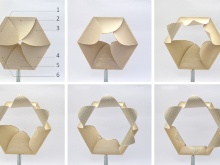Responsive autonomous surface structures inspired by passive multi-phase plant movements
The built environment is responsible for a major part of global energy consumption, which makes weather responsive adaptive building envelops increasingly important. While weather responsive architecture is typically conceived as an added function with numerous sensing, actuating and regulating devices, a fundamentally different design strategy for environmental responsiveness has evolved in biological systems. Hygroscopically actuated plant structures present highly relevant biological concept generators for the development of weather-adaptive, autonomously actuated, passive building envelopes that require neither mechanically movable parts and electronic control nor operational energy.
The aim of this project is to identify construction and functional principles of plant structures at various hierarchical levels that will be abstracted and implemented into architecture. Our focus is on structures that perform multi-phase motion, i.e. sequences of diverse motion steps. In order to achieve this goal, this research project brings together plant biomechanics, structural mechanics, chemistry, and computational design and digital fabrication. A comparative analysis of the various functional principles will form the basis for establishing parametric geometrical, topological, kinematic and mechanical models. Such a thorough quantitative analysis, simulation and abstraction of multi-phase motion principles will enable the design of biomimetic devices with tailored multi-phase motion responses and lead to a better understanding of the model plants. In order to achieve the transfer to technology, the development of a new class of 3D-printable hydrogel assemblies, as well as their integration in new environmentally responsive architectural envelopes will be undertaken.
Publications:
Tahouni, Y., Krüger, F., Poppinga, S., Wood, D., Pfaff, M., Rühe, J., Speck, T., Menges, A.: 2021, Programming sequential motion steps in 4D-printed hygromorphs by architected mesostructure and differential hygro-responsiveness. Bioinspiration & Biomimetics. (DOI: 10.1088/1748-3190/ac0c8e) link
Tahouni, Y., Cheng, T., Wood, D., Sachse, R., Thierer, R., Bischoff, M., Menges, A.: 2020, Self-shaping Curved Folding: a 4D-printing method for fabrication of curved creased origami structures. In Symposium on Computational Fabrication (SCF '20), November 5–6, 2020, Virtual Event, USA. ACM, New York, NY, USA. (doi: 10.1145/3424630.3425416) link
Krüger, F., Thierer, R., Tahouni, Y., Sachse, R., Wood, D., Menges, A., Bischoff, M., Rühe, J.: 2021, Development of a Material Design Space for 4D-Printed Bio-Inspired Hygroscopically Actuated Bilayer Structures with Unequal Effective Layer Widths. Biomimetics, 6, 58. (DOI: 10.3390/biomimetics6040058) link
PROJECT TEAM
Institute for Computational Design and Construction, University of Stuttgart
Yasaman Tahouni, Tiffany Cheng, Dylan Wood, Prof. A. Menges
Plant Biomechanics Group Freiburg, University of Freiburg
Dr. Simon Poppinga, Prof. Dr. T. Speck
Institute for Structural Mechanics, University of Stuttgart
Rebecca Thierer, Renate Sachse, Prof. Dr.-Ing. M. Bischoff
Department of Microsystems Engineering, Chemistry and Physics of Interfaces, University of Freiburg
Friederike Krüger, Prof. Dr. J. Rühe
PROJECT FUNDING
Ministerium für Wissenschaft, Forschung und Kunst (MWK)


